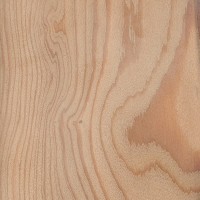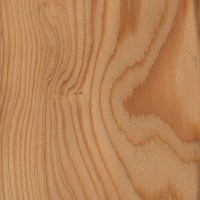 |
Common Name(s): Japanese Larch Scientific Name: Larix kaempferi (syn. L. leptolepis) Distribution: Japan, also grown on plantations in Japan and Europe Tree Size: 65-130 ft (20-40 m) tall, 2-3 ft (.6-1 m) trunk diameter Average Dried Weight: 31 lbs/ft3 (500 kg/m3) Specific Gravity (Basic, 12% MC): .39, .50 Janka Hardness: 600 lbf (2,670 N) Modulus of Rupture: 11,610 lbf/in2 (80.1 MPa) Elastic Modulus: 1,270,000 lbf/in2 (8.76 GPa) Crushing Strength: 6,010 lbf/in2 (41.4 MPa) Shrinkage:No data available |
Color/Appearance: Heartwood ranges from yellow to a reddish brown. Narrow sapwood is nearly white and is clearly demarcated from the heartwood. Flatsawn sections can exhibit a lot of character and interesting patterns in the growth rings. Knots are common but are usually small.
Grain/Texture: Grain is generally straight. Texture is medium to fine with a greasy or oily feel.
Rot Resistance: Moderately durable regarding decay resistance.
Workability: Most hand and machine operations produce good results. However, Japanese Larch is high in silica content and will blunt cutting edges. Also, because of the disparity between the soft earlywood and the hard latewood, sanding can create dips and uneven surfaces.
Odor: Japanese Larch can have a distinct resinous odor when being worked.
Allergies/Toxicity: Although severe reactions are quite uncommon, wood species in the Larix genus have been reported to cause skin irritation, as well as hives and skin lesions. See the articles Wood Allergies and Toxicity and Wood Dust Safety for more information.
Pricing/Availability: Japanese Larch is grown on plantations and is harvested in both Japan and Europe for construction lumber. Prices should be moderate within its local range(s).
Sustainability: This wood species is not listed in the CITES Appendices, and is reported by the IUCN as being a species of least concern.
Common Uses: Utility poles, fence posts, boatbuilding, decking, furniture, and construction lumber.
Comments: Japanese Larch is somewhat lighter than most other species of Larch, but it still has very good strength properties for its weight.
None available.
Scans/Pictures: There are currently no pictures of this exact wood species, but a similar species within the Larix genus is being substituted (L. decidua). If you’d like to contribute a wood sample of this specific species to be scanned, (even small pieces of veneer can be sent), please use the contact form.





